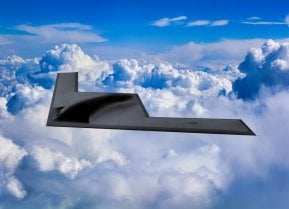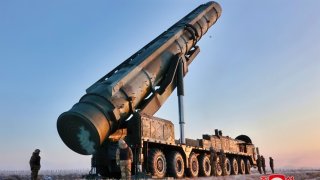The Politics of North Korea’s ICBM Program
It appears that North Korea's Kim Jong-un is now practicing “ICBM politics.” Successful ICBM launches generate internal political support. His successful ICBM tests remind the ROK citizens of reasons to question the reliability of the U.S. nuclear umbrella.
In another world, it would be reasonable to expect North Korea to rank among the strongest and wealthiest countries across the dimensions of national power, just like its neighbor, South Korea. After all, the North Korean people are in many ways similar to their South Korean counterparts in terms of talent, capability, determination, resourcefulness, and so forth. It’s hard to believe now, but fifty to sixty years ago, North Korea was the industrial powerhouse of the peninsula. Even today, the North reportedly possesses roughly $8 trillion of untapped mineral deposits.
It is, therefore, one of the world’s serious anomalies that North Korea is, at best, a third-world country. It is unable to provide adequate food and healthcare for its people or reliable electrical power for its economy.
Why? The failure of the Kim regime to provide for its people lies in its insatiable appetite for nuclear arms. The regime does not seek prosperity and a good life for its people, conditions which would allow the North Korean people wide access to outside information and resources to elude regime control. Instead, the regime seeks survival through brutal and pervasive population control and repression. It also seeks dominance over the ROK. Achieving such dominance would not be an easy task for the North as few ROK citizens would want to be immersed in the poverty and misery suffered by the North Korean people.
How does the North Korean regime explain this misery to its people? It claims that it is in part the fault of their inveterately hostile enemy, the United States. The regime even argues that the United States wants to invade North Korea. Therefore, the regime must build a substantial military equipped with defensive nuclear weapons. The acquisition of these weapons and the missiles required to deliver them is meant to demonstrate to the North Korean people that the regime is a powerful player on the world stage. In addition, the regime’s nuclear weapons and ballistic missiles capable of threatening its enemies are some of the few successes that the regime can claim. This makes it extremely unlikely that the regime would ever commit to giving them up.
North Korea’s ICBMs also play an important role in its objective to dominate the ROK. While for decades, the ROK and the United States have anticipated that North Korea would seek to achieve that goal by repeating its 1950 invasion of the ROK, the North knows that such an effort would be extraordinarily risky. The United States has threatened that the regime will not survive if it uses nuclear weapons. But equally of concern to North Korean leader Kim Jong-un is that if his forces invade the ROK, they will be exposed to a mass of outside information that could jeopardize his regime from the inside. Indeed, Kim even labels K-pop a “vicious cancer” that could undermine his regime.
Kim, therefore, appears to have adopted an alternative strategy. He has built nuclear-armed military forces, which have led a plurality of ROK citizens to consider the North militarily superior. Kim, therefore, likely strives to break the ROK-U.S. alliance, hoping that once he has done so, he can force the ROK people to accept North Korean dominance because of its military superiority.
While for decades, the ROK people trusted U.S. extended deterrence and its “nuclear umbrella,” things have changed. In January 2023, ROK President Yoon said, “The strategy of ‘nuclear umbrella’ or ‘extended deterrence’ is no longer reassuring for the [ROK] public now that North Korea has developed nuclear weapons and a range of missiles to deliver them.” Part of the problem is that the U.S. withdrawal from Afghanistan had an unexpectedly serious impact on the ROK, raising questions about whether the ROK can trust the United States to deter or defeat the existential threat that North Korean nuclear weapons are posing. And now that North Korean ICBMs are demonstrating an ability to attack U.S. cities with nuclear weapons, Kim Jong-un is repeatedly claiming that he is prepared to use nuclear weapons against the United States.
The ROK public is thus asking: Will the United States respond to North Korean nuclear weapon use? By doing so, the United States might suffer North Korean nuclear attacks against Washington DC, New York, Chicago, San Francisco, or any other city. Or will the United States say that short-range missiles that could be used against the ROK are “not a threat to the United States”?
Interestingly, North Korea has carried out eleven full or partial ICBM tests over the last two years. And yet, historically, North Korean elite escapees claim that North Korean doctrine holds that missile tests confirm the successful development of new missiles—technically unnecessary tests are just too expensive. With three successful tests of the latest North Korean ICBM already this year, Kim Jong-un has departed from this historical doctrine.
It appears that Kim is now practicing “ICBM politics.” Successful ICBM launches generate internal political support. His successful ICBM tests remind the ROK citizens of reasons to question the reliability of the U.S. nuclear umbrella. Little surprise then that Kim conducted his latest ICBM test immediately after the results of the second ROK-U.S. Nuclear Consultative Group meeting, a meeting designed to strengthen ROK nuclear assurance. Kim apparently concluded that he needed to stimulate ROK doubts, which led to discussions about developing ROK nuclear weapons. This act could undermine the viability of the ROK-US alliance. After all, the United States uses the Nuclear Nonproliferation Treaty as the bulwark of its global nuclear nonproliferation efforts. The ROK’s development of nuclear weapons could jeopardize the future of this treaty.
With major ROK and U.S. elections in 2024, Kim can be expected to further test his ICBMs for primarily political purposes. In June this year, the U.S. published a National Intelligence Estimate extract projecting that the North will use its nuclear weapon program for such coercive purposes. The ROK and U.S. governments need a coherent strategy for countering this coercion.
About the Author
Bruce W. Bennett is a senior international/defense researcher at the nonprofit, nonpartisan RAND Corporation. He works primarily on research topics such as strategy, force planning, and counterproliferation within the RAND International Security and Defense Policy Center.
Image Credit: North Korean State Media.


